Florida State University have consistently had one of the strongest programs over recent years in NCAA women’s soccer and once again this past season Head Coach Mark Krikorian put together another truly outstanding side.
This tactical analysis gives an in-depth analysis of the tactics used by Mark Krikorian by looking at some of their final games of the 2020 season and discussing the tactical tendencies evident in these fixtures.
Formation
One of FSU’s major strengths comes from their consistency in how they set up. This past season they displayed a settled starting XI, and a clear and understood game model. Krikorian built a side that were calm and purposeful in their build-up, whilst using a compact and competitive defensive shape to frustrate the opposition and dominate the second ball.
FSU favoured using a back four and a midfield three. They would either opt to play with a double or single pivot, but Jaelin Howell is such an impressive talent in the “6” that she can comfortably play as a single pivot and allow FSU to push the rest of their midfield further forward. In fact, against Notre Dame, FSU played with a really interesting back three/four hybrid where Howell was given the freedom to drop in as a centre-back for periods of the game, and drive the ball forward as she saw fit.
Howell was fully deserving of her international call-up for the recent She Believes Cup, and looks destined for a long and fruitful career.
The rest of the line-up depends on how far forward their wingers are used, whether they’re used as just that, or as wide forwards. However, generally FSU’s formation lies somewhere between a 4-5-1 and a 4-3-3. Their attacking shape will vary between the aforementioned two formations and in defence they might initially press in a 4-3-3, but will generally fall back into a 4-5-1 as they drop deeper.
Stretching the opposition
As soon as FSU gain possession it instantly becomes clear they wish to make the pitch as wide as possible. They defend in an overly narrow, compact shape, which I will detail later, but they transition so quickly into a very wide shape.
The full-backs immediately push out to hit the touchline on either side and this creates an easy pass option out of the crowded central channel, but also stretches the opposition too.
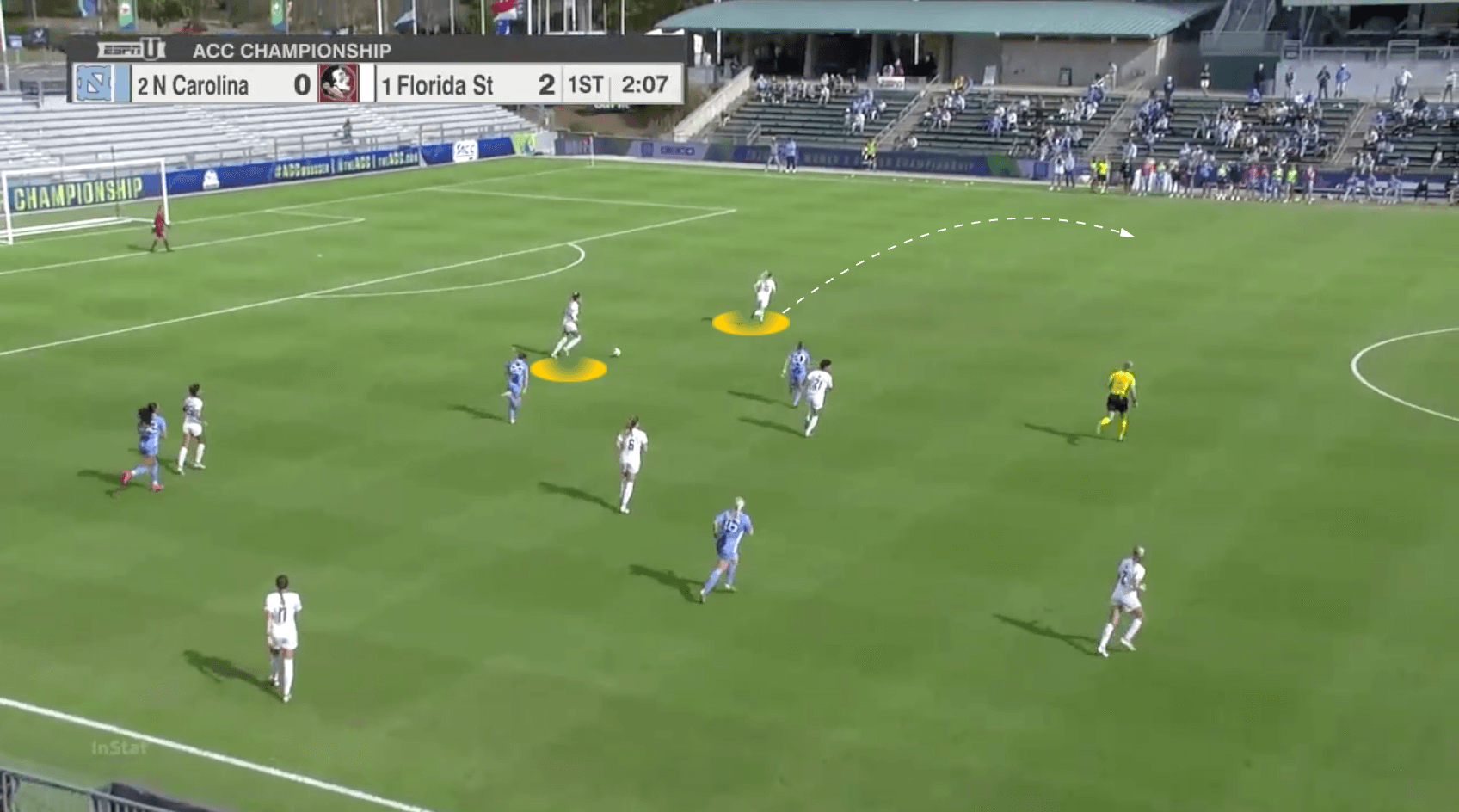
By stretching the pitch horizontally and making the opposition less compact it opens up forward passing lanes for FSU to exploit. It creates space for them to play directly into the front line, or behind the opposition defence, or simply to just play forward into the midfield.
With the defence stretched they will look to hit the gaps in between and they have the speed up front or from the wings to hurt teams with these balls in behind. The centre-backs, Emily Madril and Malia Berkely, along with Jaelin Howell in the pivot, all showed the ability to hit accurate longer passes, whether with diagonal switches of play, or with these searching through passes. Berkely was particularly outstanding in this aspect, and as a result she is now playing against the likes of Lyon and PSG on a weekly basis thanks to her move to Bordeaux.
One pass they look for upon transition is that long ball in between the opposition centre-back and full-back, as the winger pushes wide, before cutting back inside.
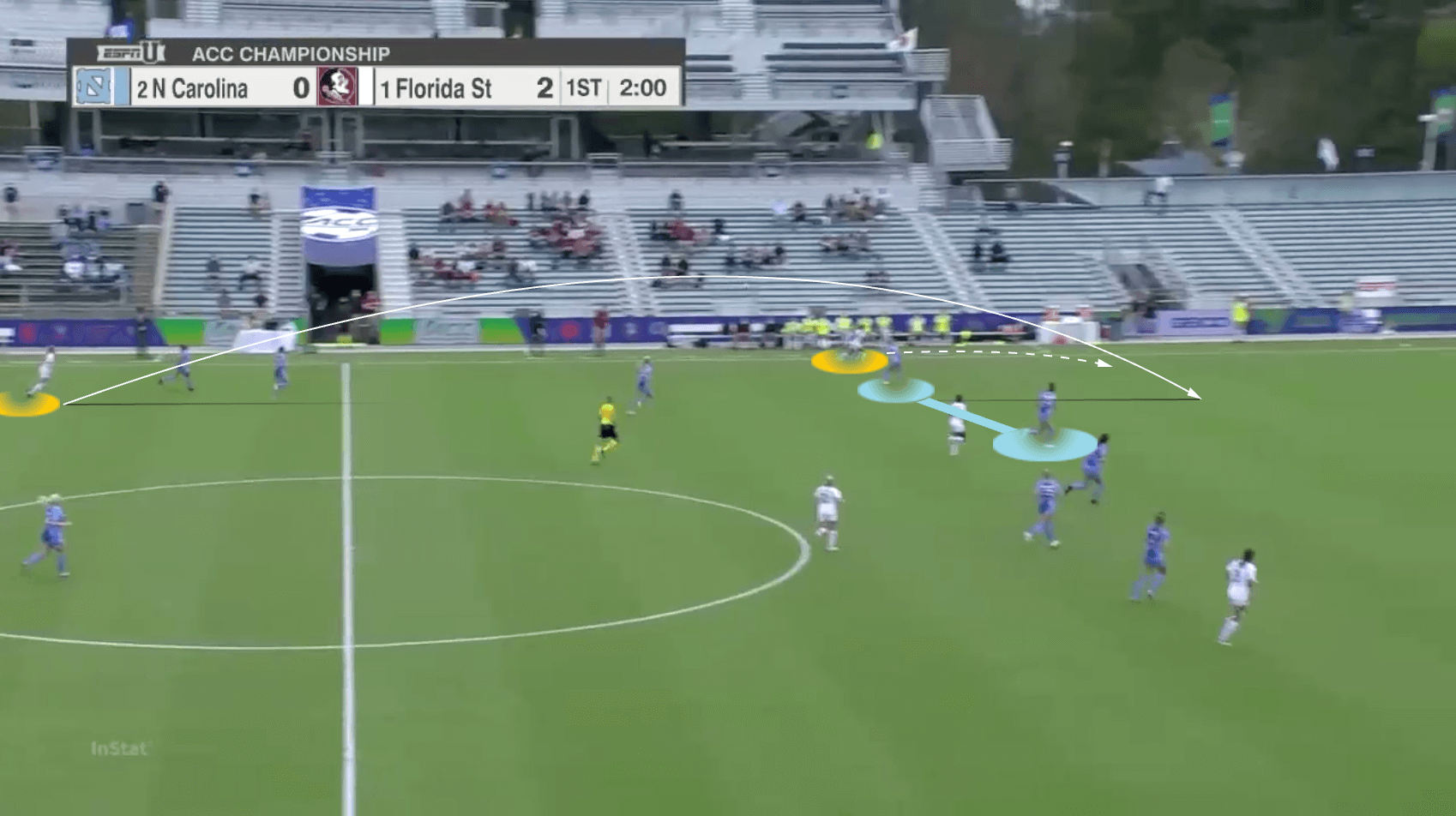
The use of the wide and flat back four gives FSU an advantage when facing a high press and they are able to circulate and bypass it, or if the opposition press is stretched as a result of FSU’s width they will break the lines and play straight into Howell or further forward.
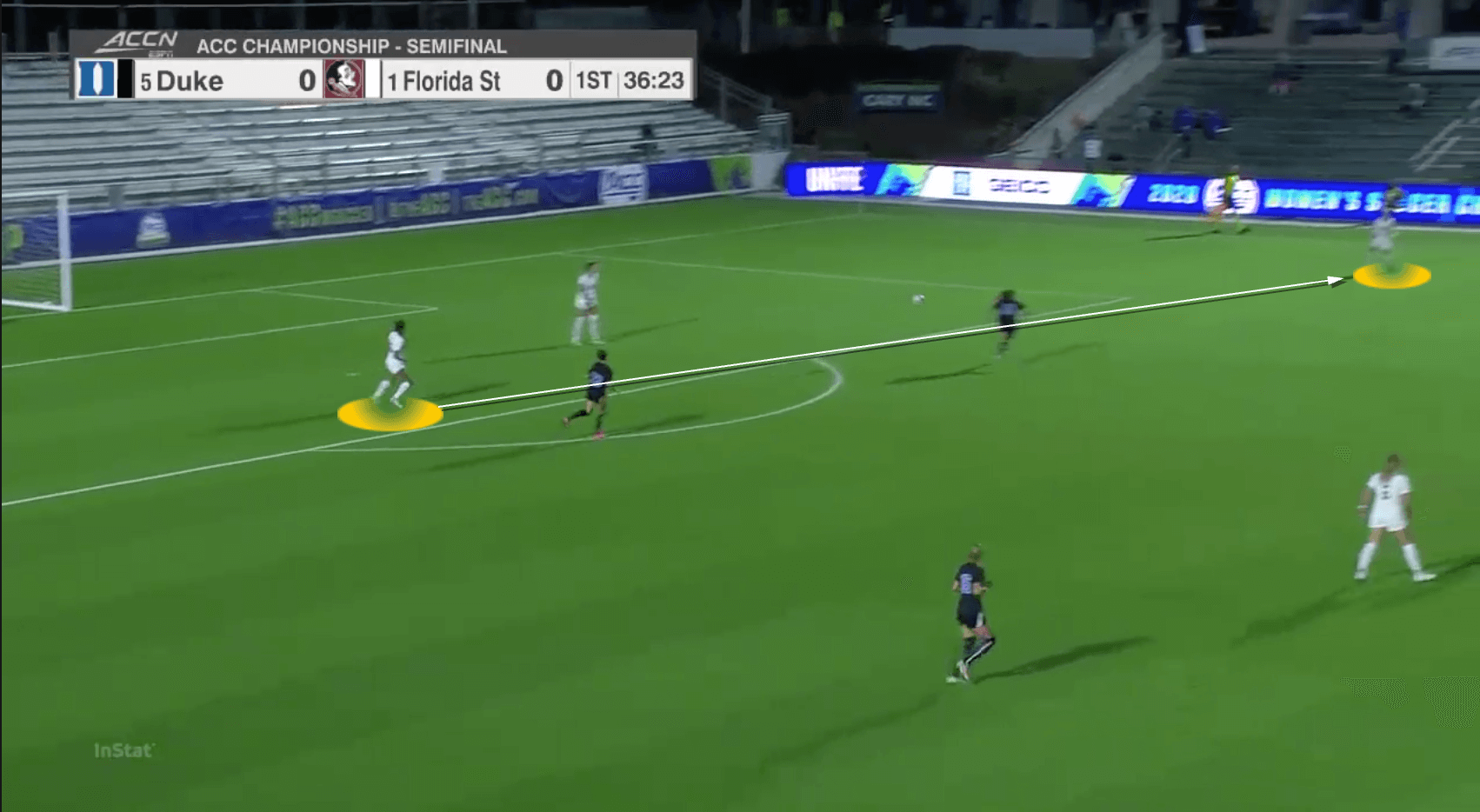
They circulate the ball to give time for their attacking players to move into a position where they can find them with a direct pass as well. It’s not unusual to see the centre-backs working the ball just between themselves, particularly when the full-backs aren’t as flat and wide.
When playing against FSU, a press from the opposition where the centre-forward curves their run and forces FSU to either play wide or play forward perhaps without being ready would make a lot of sense here. A lot of teams allow them to circulate, but there is a way to structure a press where this is prevented and if Howell is in close proximity she could be kept in the shadow of the pressing player too.
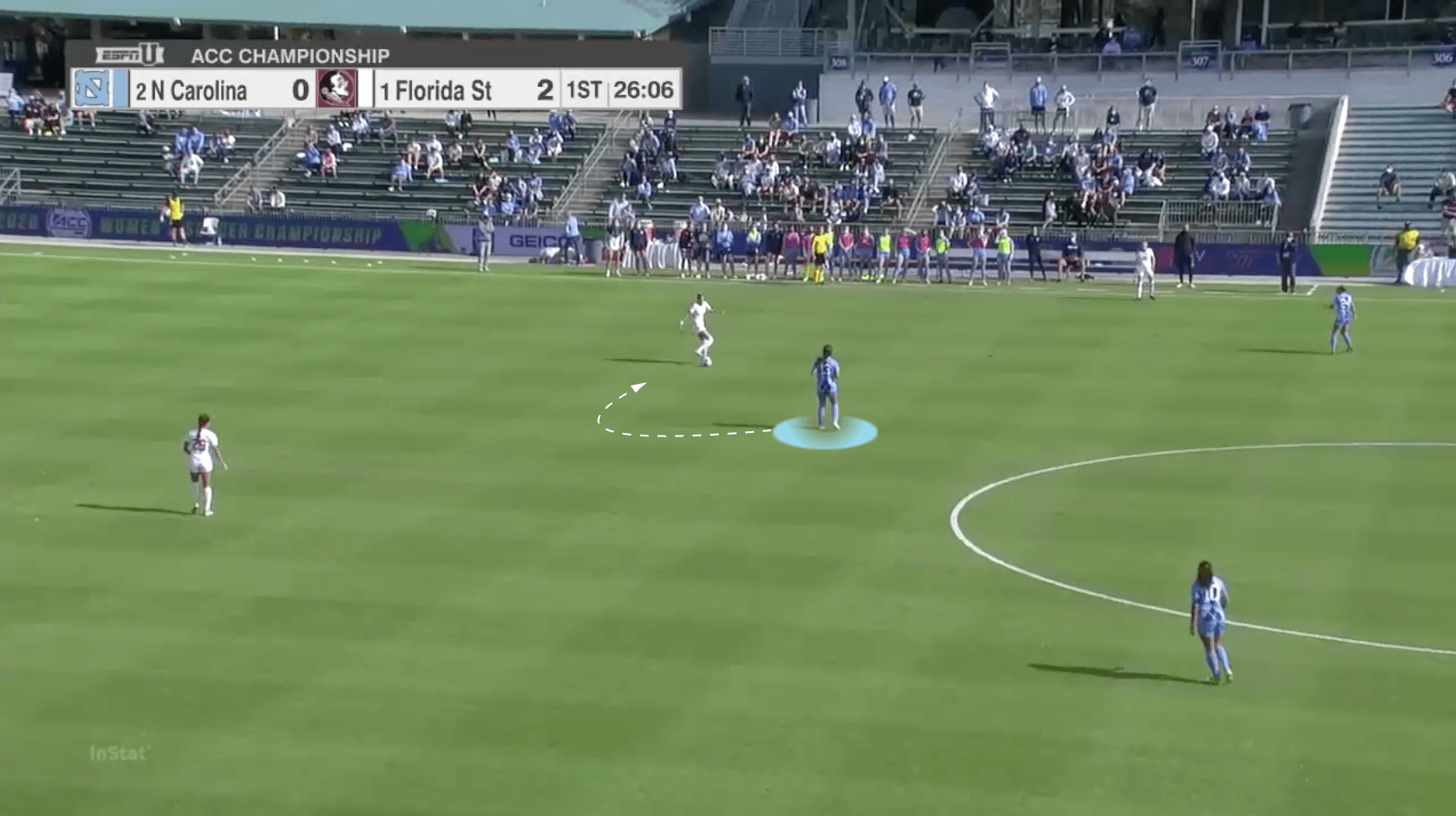
FSU exert a great deal of control over games, and so much of their play is dictated by their players at the back, specifically that core three of the two centre-backs and Howell. When they regain possession they so frequently work the ball back and restart another attack from the back, looking to dictate the play and break down the opponent from this area. It shows a confidence in their game plan but it also wears down the opposition who have to withstand wave after wave of attacks.
Howell isn’t just a player who has a range of passing either. She is truly an outstanding talent and is excellent driving forward on the ball from deep too. As such, she is a key ball progressor for FSU, and for any side to get a result against this side, they will have to solve the puzzle of how to contain Howell.
If the opposition sit back, Howell will happily pick the ball up from her back line, and drive forward into the space with it.
Whilst in the final third FSU continue to look to stretch the opposition across the width of the pitch before picking them apart with passes between the gaps in the defence. They did a terrific job in the ACC Championship semi-final of drawing Duke’s left-back out to the wing and exploiting the space with flat passes in behind. Due to the central presence FSU have from their forwards, this prevents Duke’s defence from sliding over as a compact unit, and creates the 1-on-1 for the winger, who bypasses their marker to latch onto this through pass.
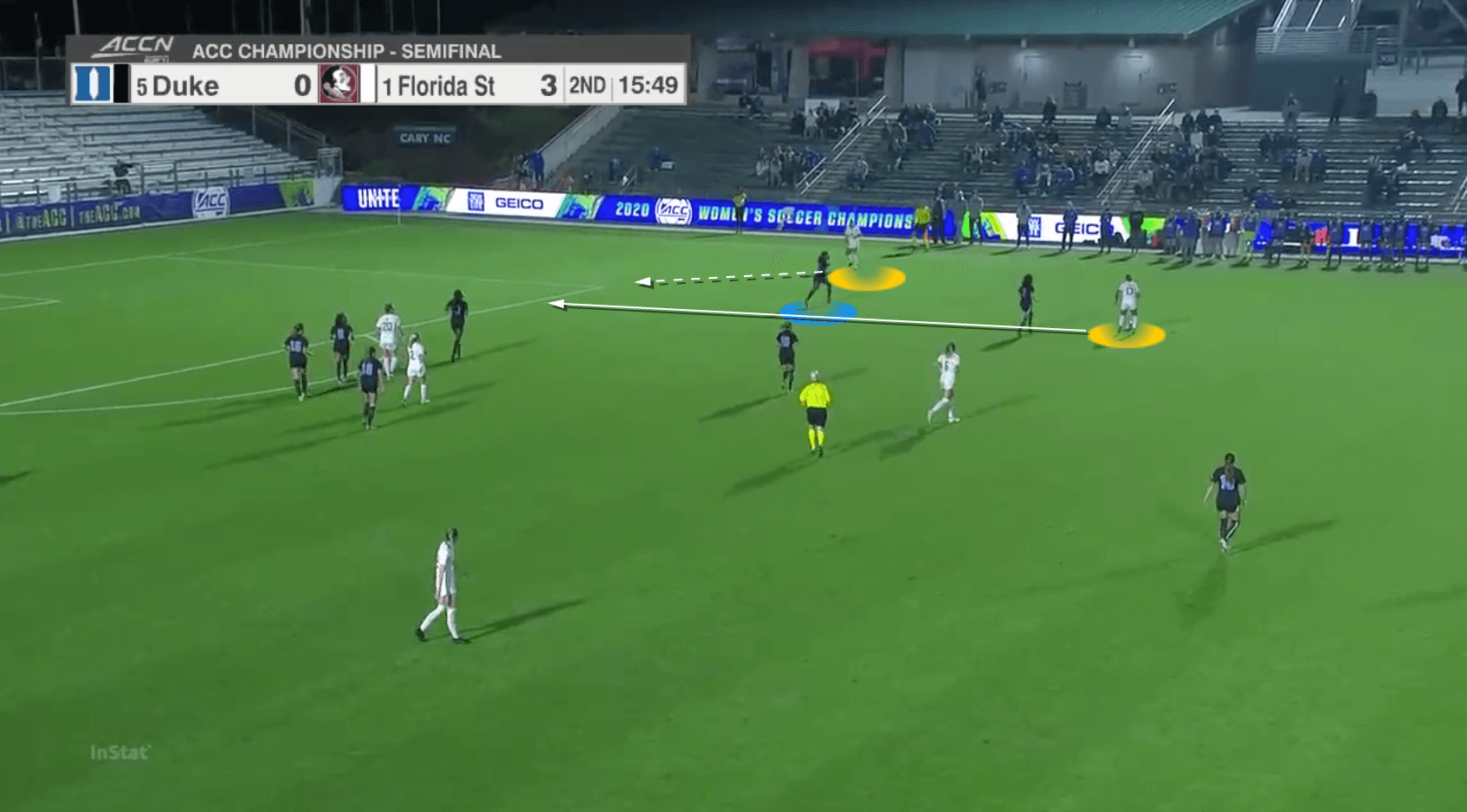
By stretching the opposition defence in this way, it creates large gaps for players to make a late run into from deeper areas too. Below we can see an FSU player making a late run from midfield into the half-space behind the Virginia defence.
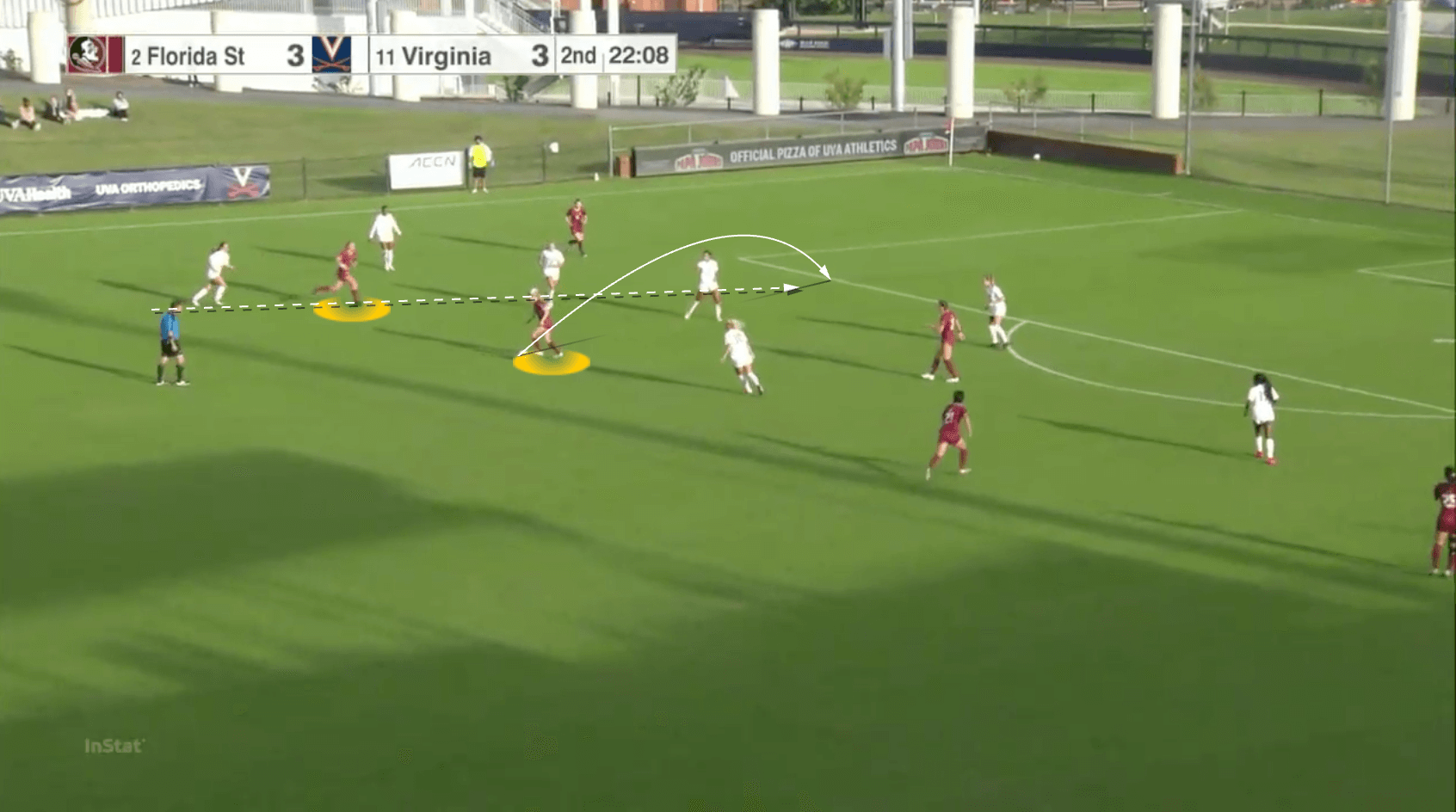
And these stretched defences also leave more space for FSU’s centre-forwards to make runs in behind as well. Below we can see striker Jody Brown making a run in between the left-sided centre-back and left-back of Duke. Her run is duly met by the through pass before scoring.
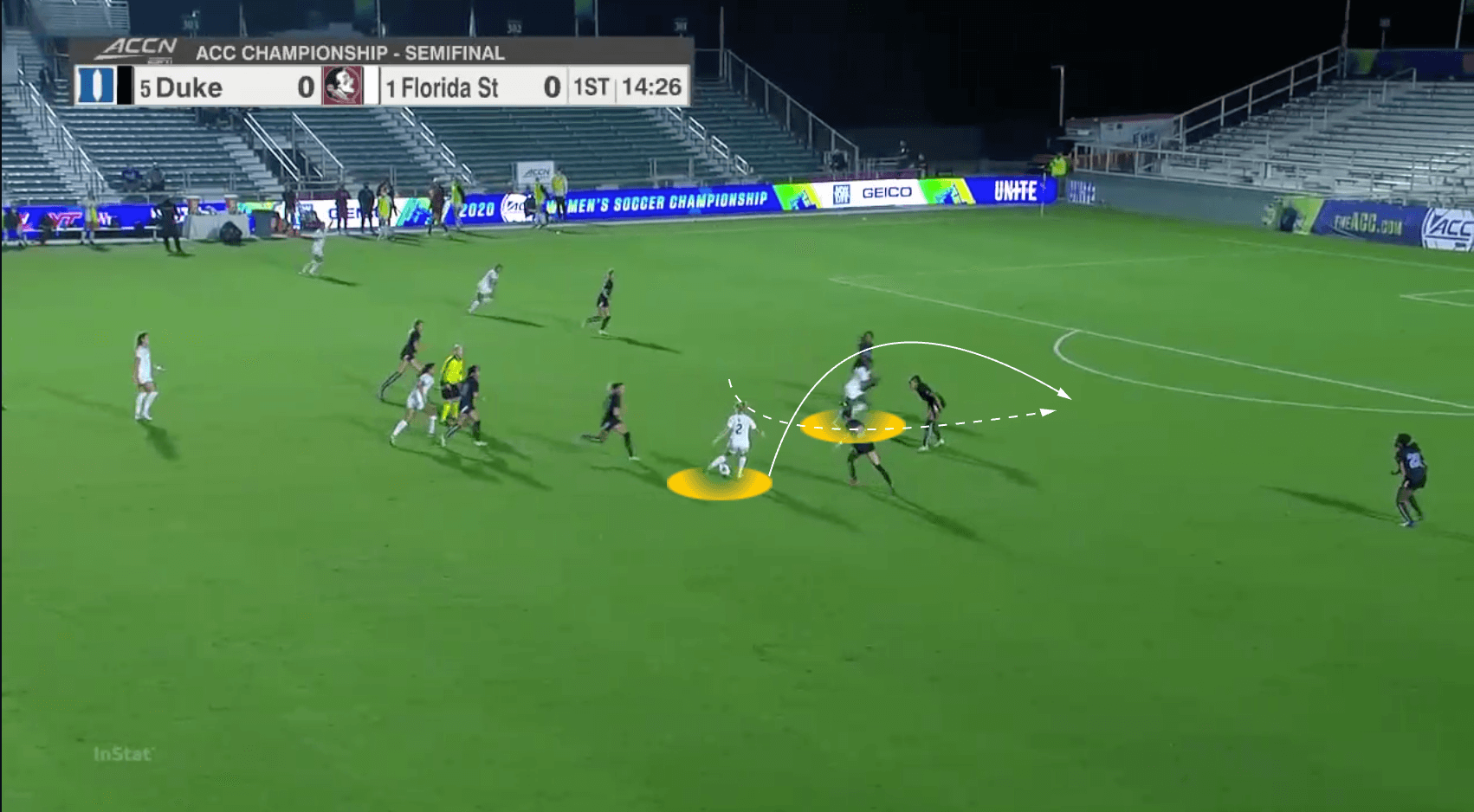
Late runs are a common occurrence in their attacking play.
Below, Leilanni Nesbeth makes a late run to the edge of the box, and with her forward making a run towards the front post, and occupying both centre-backs, this leaves Nesbeth free to strike home from this distance. This is a pass pattern that appears with some frequency and teams will have to be aware of the late run that is purposefully picked out with a pulled-back cross.
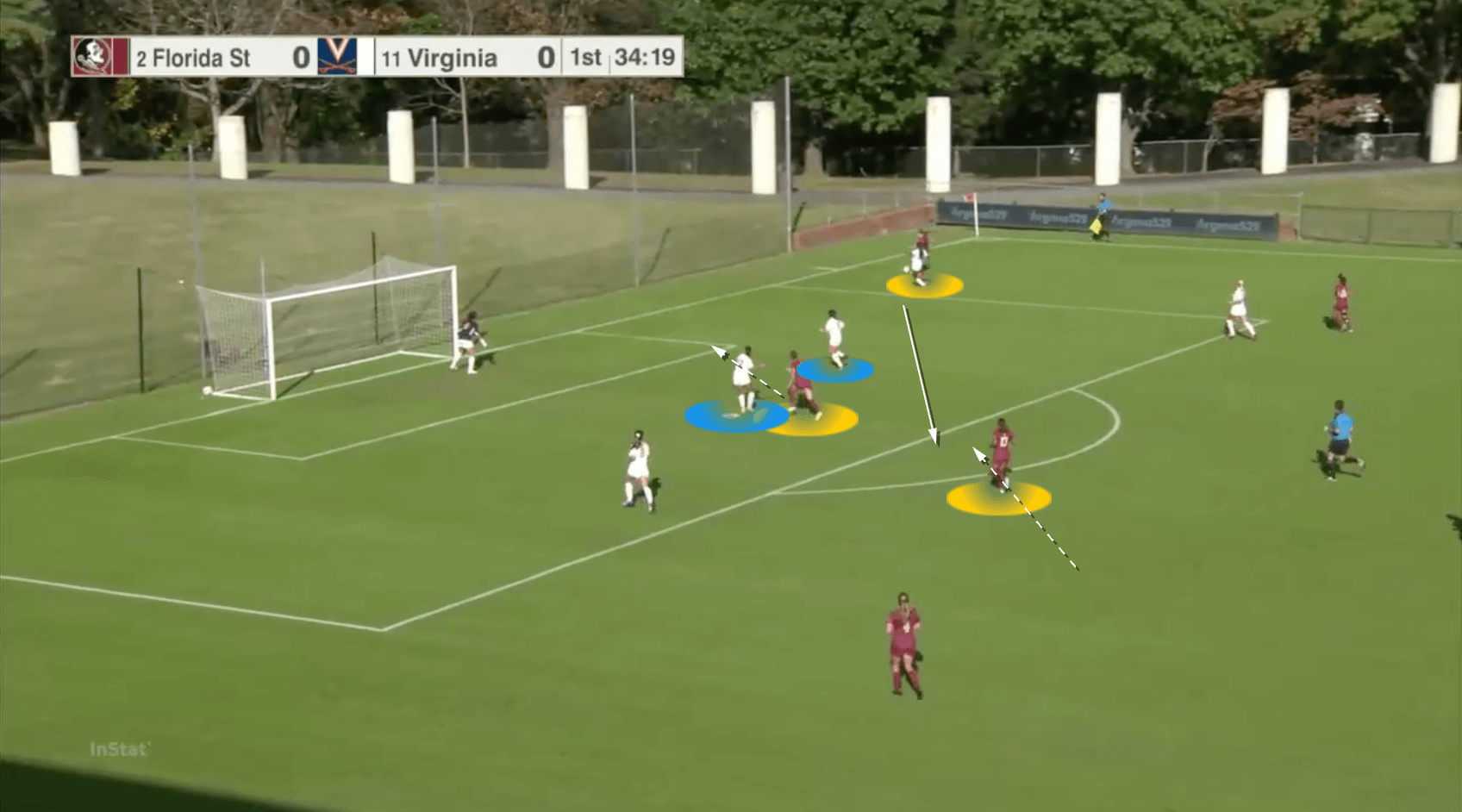
There is a weakness though, which arises from FSU’s attacking zeal. They have no issue leaving just two centre-backs back, and pushing both full-backs on. If Howell isn’t deep enough to protect then this can lead to counter-attacking opportunities should they lose possession. Their centre-backs last season both displayed excellent pace but with Berkely moving on, it will be interesting to see if they are this cavalier with their attacking shape going forward.
Defending
FSU vary with the intensity of their press, but when they press high we see an angled press to show the opponent away from the centre of the pitch. The angled press from the centre-forward is often supported by the ball-side winger also pushing forward ready to press a pass to the full-back, should that occur. We can see this in the image below, and with such an aggressive pressing structure this encourages the opposition to play long. With someone like Howell patrolling in front of the back line, any long ball forward is easily swept up by FSU.
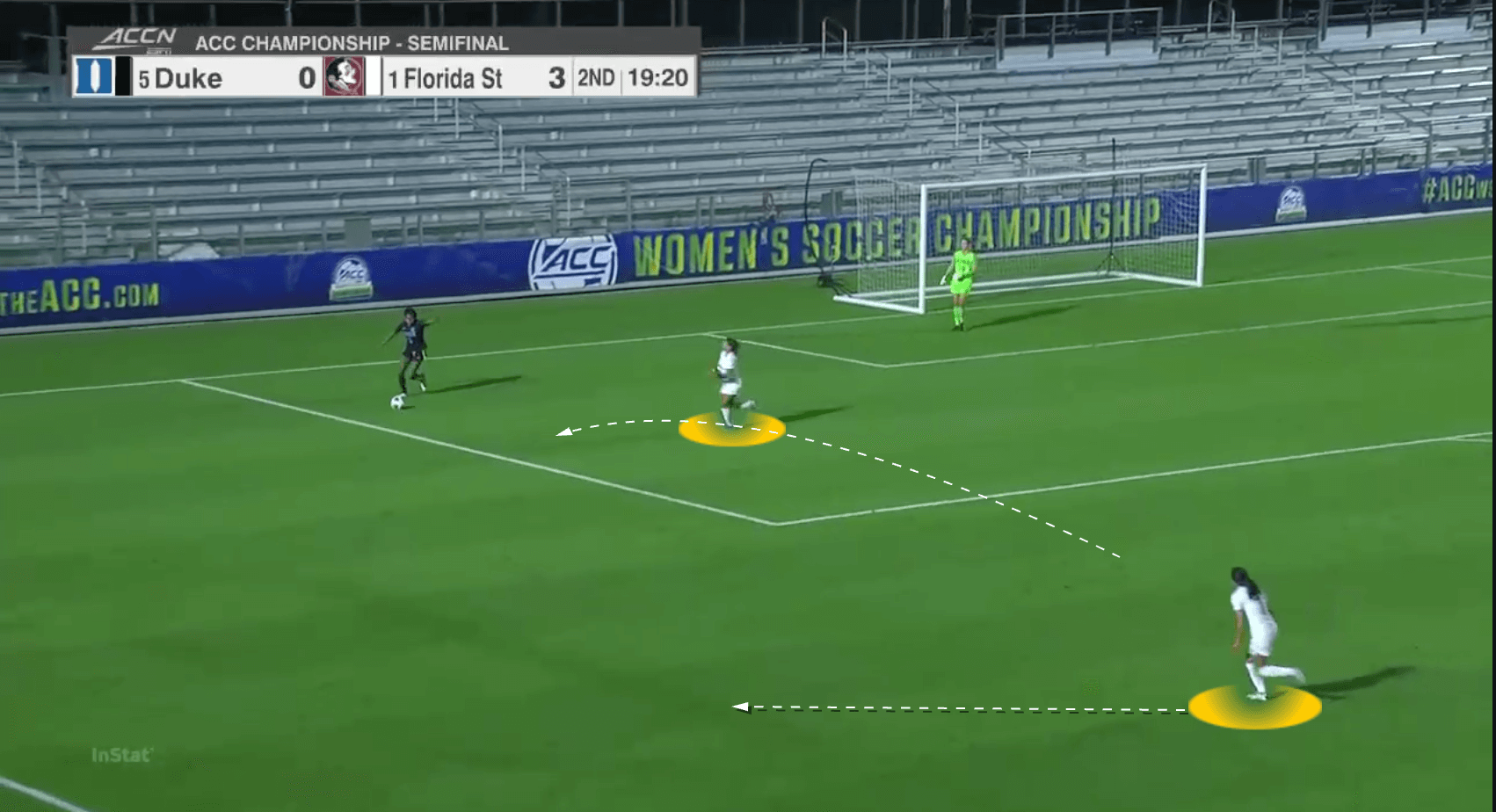
Howell is again a vital cog in FSU’s defensive system too. She breaks up play terrifically well in front of the defence, and is an imposing presence as she works across the width of the pitch to provide an agile, physical shield whose game-reading and game IQ is second to none.
Howell works particularly well as part of a midfield three that is constantly applying pressure in the middle of the pitch should the opposition look to play centrally. As a result, FSU so frequently have at least three players around the ball, pressuring. This prevents the opponent from having comfortable possession in this area, but it also structures the attacking transition. Once the ball is won in this area, FSU instantly have at least two players to support the ball-winner and they can engage in quick interchanges before often playing back to the centre-backs and starting the possession phase from there.
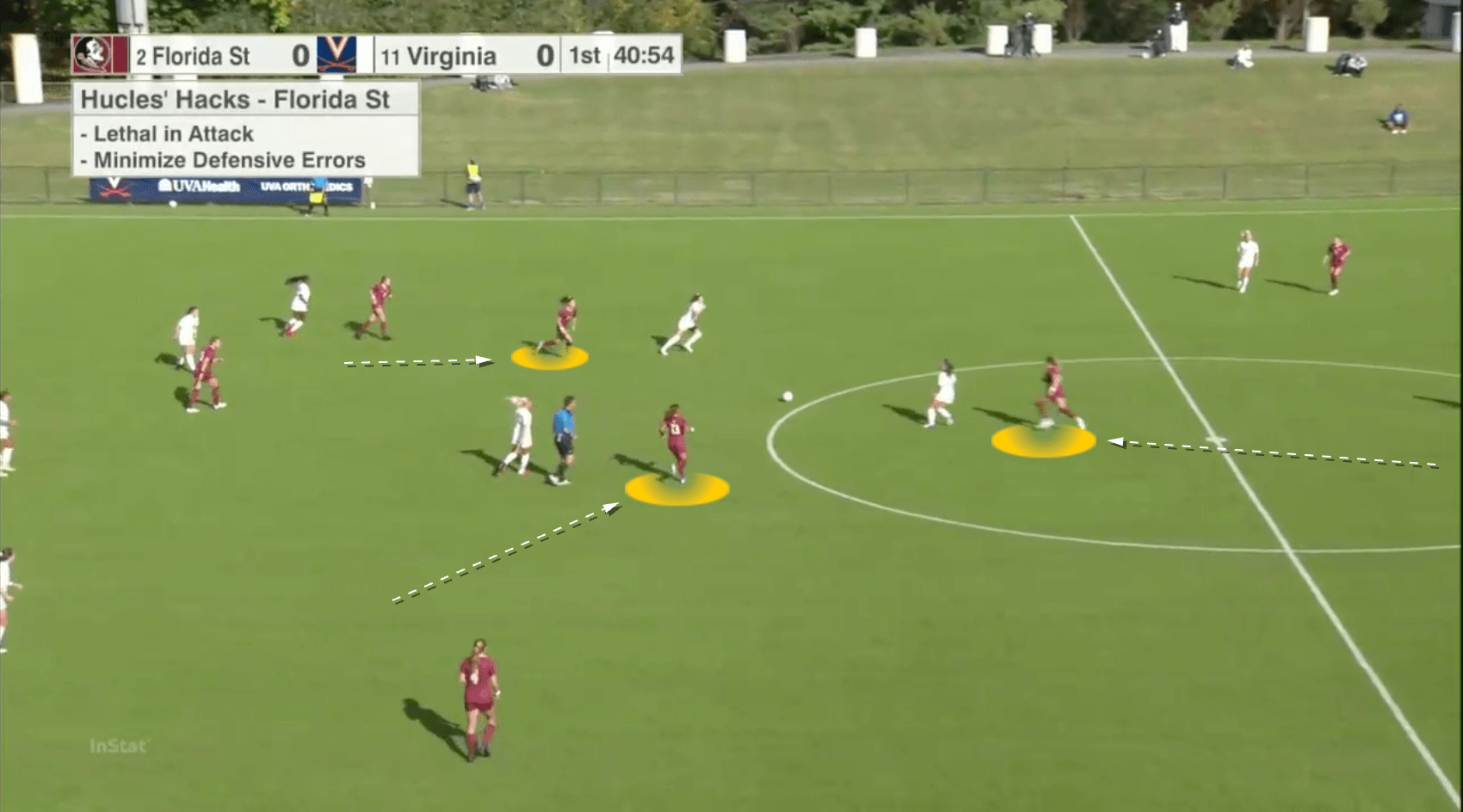
There is an area to attack though, and this presents itself in how tight FSU’s back four sit. They often are placed within 20 yards of one another, leaving plenty of space on either flank. If a team can transition quickly to provide quick options either side of them, and have a player who can consistently hit a lofted diagonal through pass, then this could be an area of concern for FSU.
Below we can see how compact their back line is, and the right-back is highlighted. She is far inside, leaving a huge gap behind her, and along with her centre-back she is focusing solely on where the ball is. A Duke player, highlighted on the right of the picture, is making their way forward, but fails to hit the specified space.
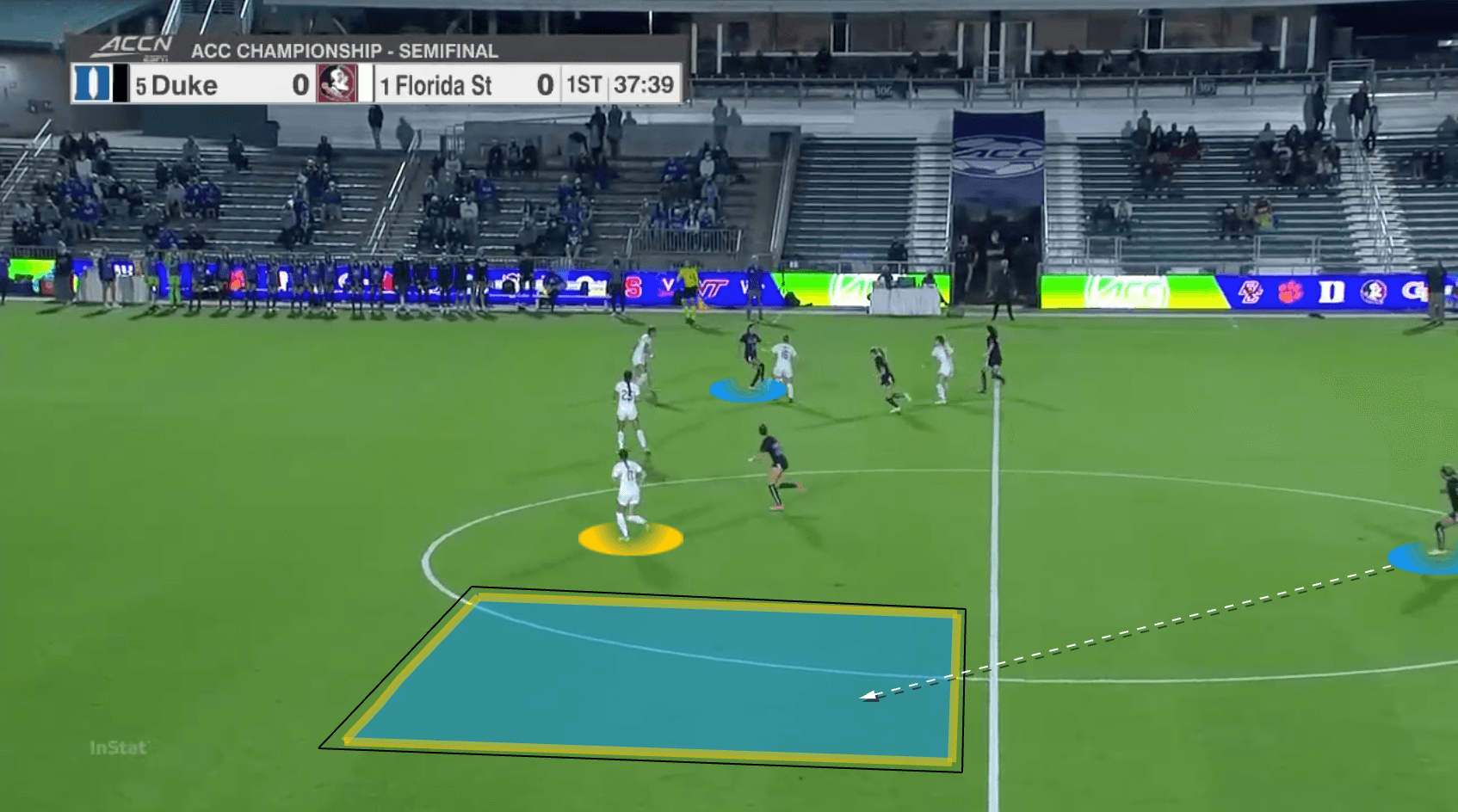
However, Virginia showed that this could be exploited, and they left a winger either side of the back four in a high and wide position. They were able to play these kinds of passes shown below, and get behind FSU’s defence in a way most teams haven’t been able to.
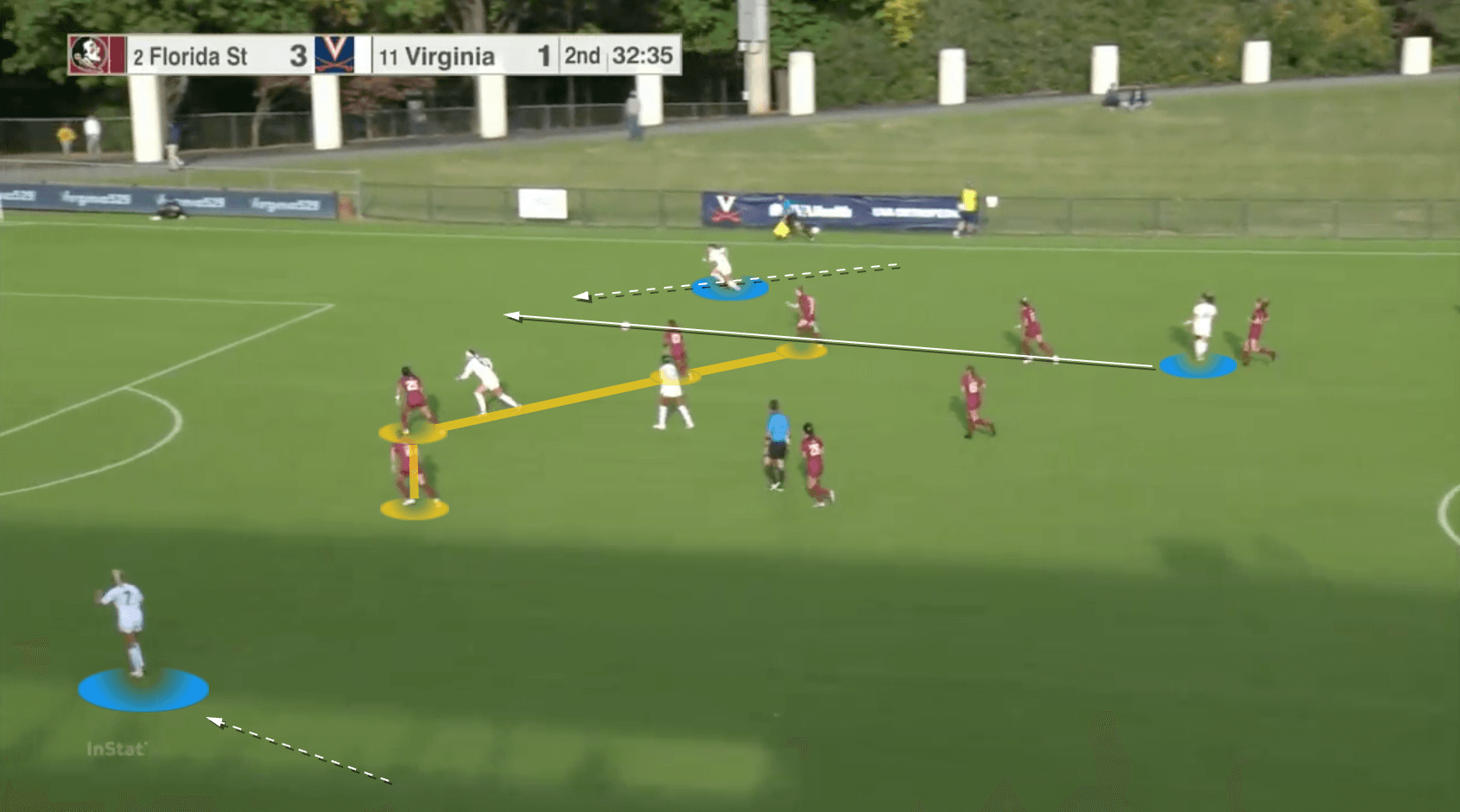
Set-pieces
FSU’s preference for a certain type of attacking corner should also be noted. This first angle shows us a cluster of FSU players inside the six-yard, whilst there are three highlighted players at the edge of the box. The two furthest out from goal are there to attack any headers away from goal, whilst the closest highlighted player to goal, drifts towards the back post.
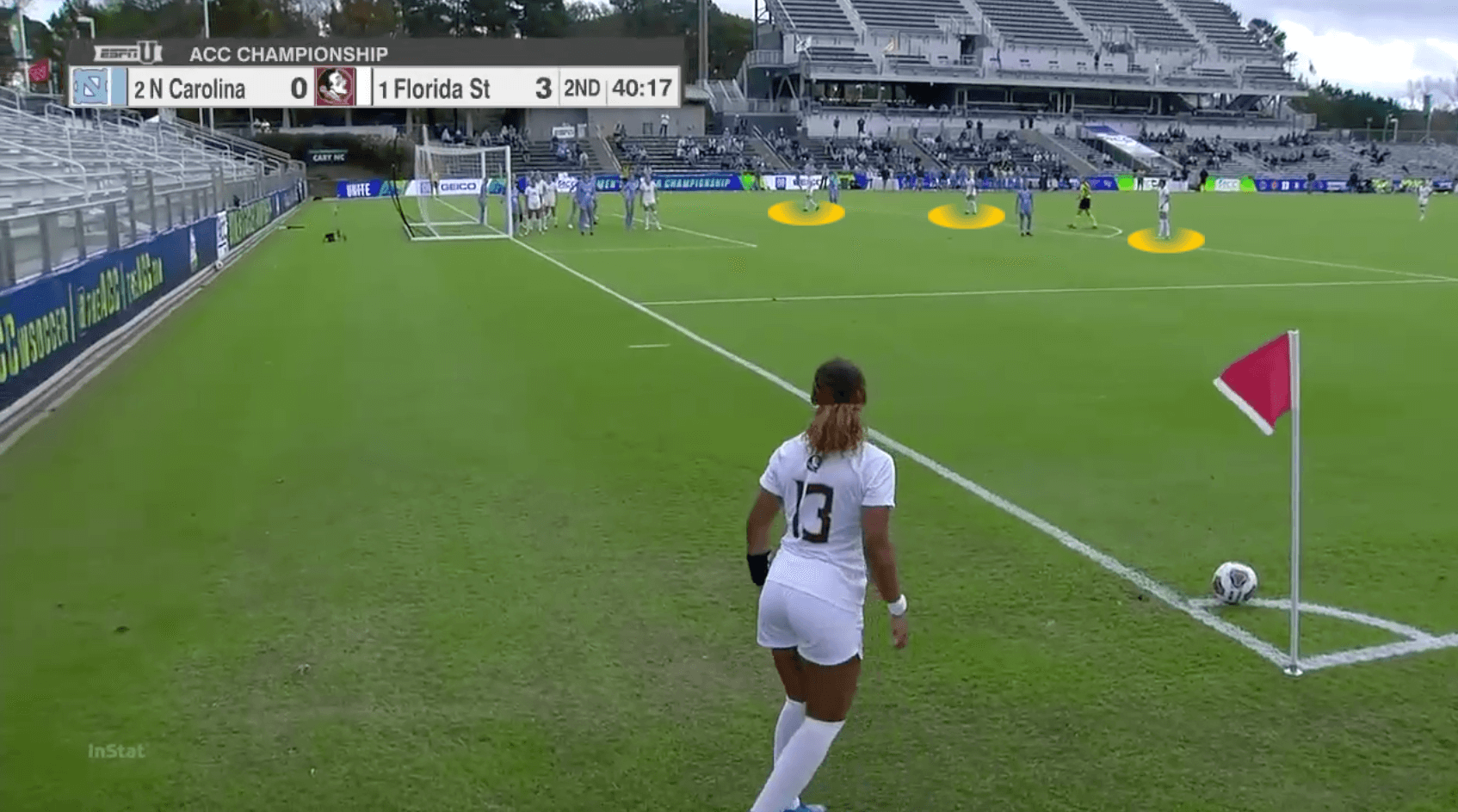
They do this, as we can see in the image below, to attack any overhit crosses. But most notable is the aforementioned cluster of players. FSU put five players inside the six-yard box, and when comprehensively marked, this can lead to it being very crowded. In fact, there are 14 players in the six-yard-box in this example.
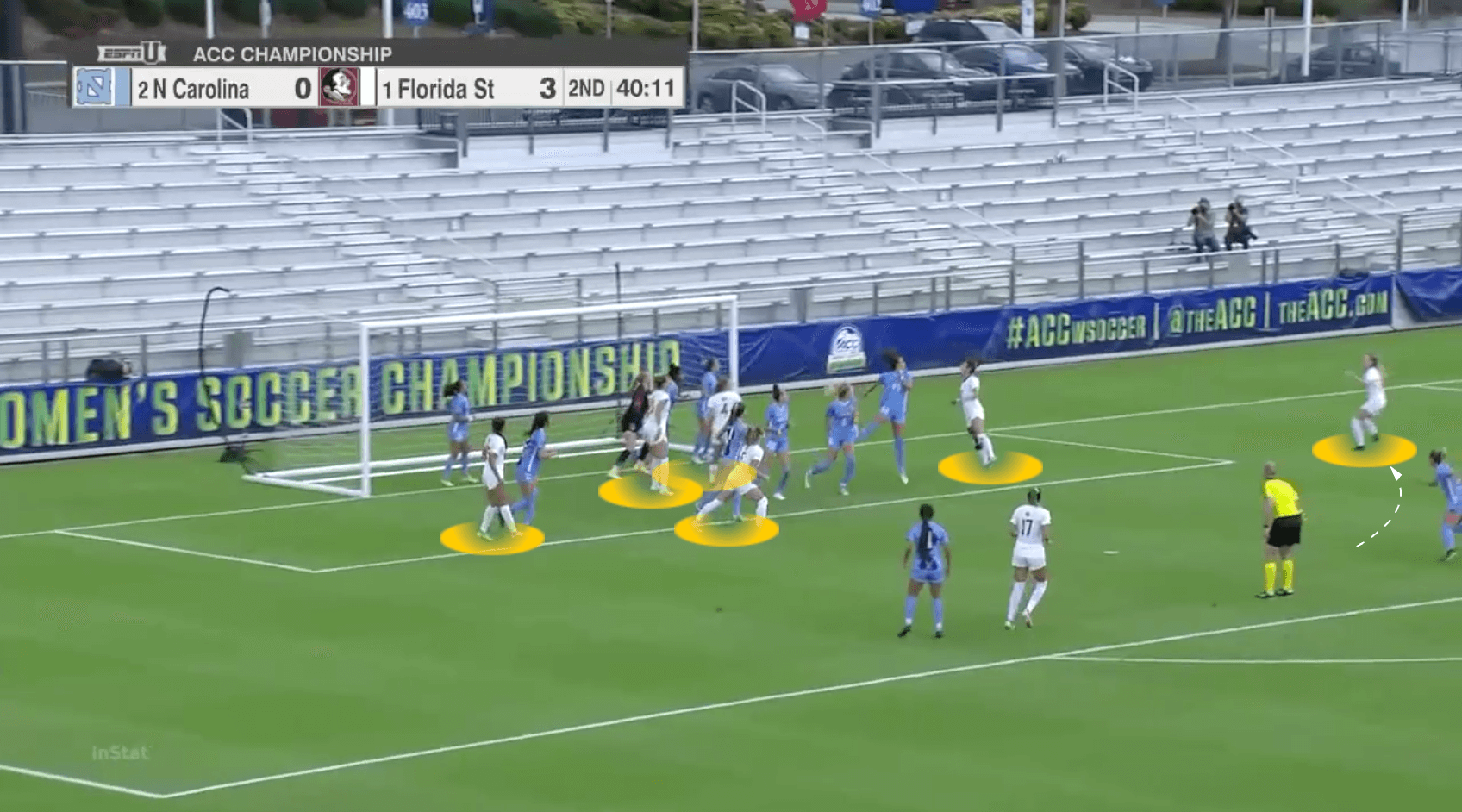
FSU look to stick a player on the keeper, to prevent them from coming for the cross, whilst the increased number of players in this area makes an inswinging corner very difficult to deal with. FSU have had success with teams not clearing the ball well and have capitalized on the ball landing clumsily in the six-yard-box where the FSU players are ready to pounce on any loose ball. And again, if the ball is headed away, they have two players on the edge of the box ready to attack this.
Conclusion
FSU are a side that control games with the ball-playing skill of their centre-back duo and pivot, Howell. They are patient in possession but are also purposeful, and FSU can be devastating with direct attacks. As a side they are littered with quick and physical players throughout their squad, and all of these players have bought into this effective game plan that Krikorian has put in place.
The departed Berkely will be sorely missed next season, but with Howell entering her junior year there will no doubt be hosts of NWSL, FAWSL and clubs from around the world looking at the midfielder. As a result this talented side will be at risk of having it’s heart pulled out. But for now, FSU will once again be a team very much in the running for another national championship.





Comments